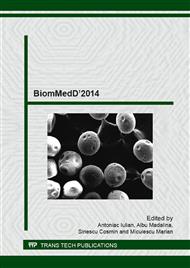p.3
p.8
p.14
p.20
p.27
p.31
p.38
p.47
A Study on Metal-Ceramic Interface on Metal Base Dental Alloys
Abstract:
Although the literature describes many studies that attempt to define and interpret the interaction between the metal component and overlying sintered ceramic mass, researchers still have conflicting opinions. It is not yet fully understood the hybrid layer occurrence phenomenon that rises by diffusion at the sintering temperature between the compositional elements of the alloy and the ceramic mass. Also, there isn’t a standardized technology test for the compatibility between the alloy for this technology and a specific plating ceramic mass, from the strength of the bond between the two components at the interface point of view.This paper aims to present the composition, properties and the interaction between the two materials that participates in obtaining metal-ceramic fixed prostheses, and tries to expose a possible method for analysing the bonding strength and compatibility between dental alloys and ceramic masses. However, the mechanical surface contamination by the migration of the chemical elements it is possible, due to the mechanical stresses during cutting and polishing due to the hardness differences between the prosthesis components.Electron microscopy analysis allows the diffusion phenomenon evaluation and of the fact that the elements with reduced concentration within the ceramic have a higher diffusivity (Al as compared with Si), and that metallic elements diffuse in the ceramic mass. The extent of this interdiffusion is probably the degree of adhesion between the two components of the mixed metal-ceramic crown.
Info:
Periodical:
Pages:
14-19
Citation:
Online since:
March 2015
Keywords:
Price:
Сopyright:
© 2015 Trans Tech Publications Ltd. All Rights Reserved
Share:
Citation:


